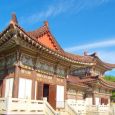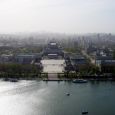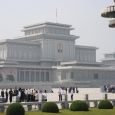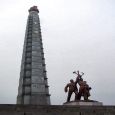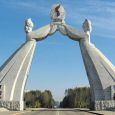Pyongyang
Advertisement
By Air
State-owned Air Koryo has scheduled flights from Sunan Capital International Airport to Beijing (PEK), Shenyang (SHE), Vladivostok (VVO), Moscow (SVO), Bangkok (BKK), Khabarovsk (KHV), Kuala Lumpur (KUL), Shanghai (PVG) and Kuwait City (KWI).Air Koryo also operates limited scheduled service to a few domestic destinations.The only domestic destinations are Hamhung, Wonsan, Chongjin, Hyesan and Samjiyon.In April 2008, Air China launched a regular service between Beijing and Pyongyang.
By Train
Pyongyang Station serves the main railway lines, including the Pyongui Line and the Pyongbu Line.The city also has regular international rail services to Beijing and Moscow.A journey to Beijing takes about 25 hours and 25 minutes (K27 from Beijing/K28 from Pyongyang, on Mondays, Wednesdays, Thursdays and Saturdays); a journey to Moscow takes 6 days.The city also connects to the Eurasian Land Bridge via the Trans-Siberian Railway.
By Bus
There is also a 53 km (33 mi) long Pyongyang tram system and a 150 km (93 mi) Pyongyang trolleybus system.The trolley bus-stops are fairly busy.It is difficult to gauge how widely the metro is used, as tourists are permitted to travel only between two designated stops with a guide.The Pyongyang Metro is a two-line underground metro system which has a length of 22.5 km (14.0 mi).The Hyoksin line serves Kwangbok, Konguk, Hwanggumbol, Konsol, Hyoksin, Jonu, Jonsung, Samhung and Rakwon stations.The Chollima line serves Puhung, Yonggwang, Ponghwa, Sungni, Tongil, Kaeson, Jonu and Pulgunbyol stations.
Kumsusan Memorial Palace
sometimes referred to as the Kim Il-sung Mausoleum, is a building located northeast of downtown Pyongyang, the capital city of the Democratic People's Republic of Korea (North Korea).The palace is the former official residence and office of North Korea's president and founder, Kim Il-sung. Following Kim Il-sung's death in 1994, his son and successor Kim Jong-il had the building renovated and transformed into his father's final resting place.Inside the palace, Kim Il-sung's embalmed body lies viewable inside a clear glass sarcophagus.His head rests on a Korean-style pillow and he is covered by the flag of the Workers Party of Korea.The palace is situated in a secluded area in Pyongyang and is only accessible to foreigners on Thursdays and Sundays on official government tours.Photography, videotaping, smoking and talking are not permitted anywhere inside the palace.It is fronted by a massive square and is bordered on its northern and eastern sides by a moat. Of the extant mausoleums dedicated to Communist leaders, Kumsusan is the largest.
Arch of Triumph
was built to commemorate the Korean resistance to Japan from 1925 to 1945.Built in 1982 on the Triumph Return Square at the foot of Moran Hill in the North Korean capital city of Pyongyang, the monument was built to honour and glorify President Kim Il-sung's role in the resistance against Japanese rule.Inaugurated on the occasion of his 70th birthday, each of its 25,500 blocks of finely-dressed white granite represents a day of his life up to that point.The structure is modelled after the Arc de Triomphe and was deliberately built to be slightly larger than the one in Paris. It is the world's tallest triumphal arch, standing 60 metres (197 ft) high and 50 m (164 ft) wide.The arch has dozens of rooms, balustrades, observation platforms and elevators.It also has four vaulted gateways, each 27 m (89 ft) high, decorated with azalea carved in their girth.Inscribed in the arch is the "Song of General Kim Il-sung", a revolutionary hymn, the year 1925, when North Korean history states that Kim set out on the journey for national liberation, and the year 1945, the end of World War II, which ended the Japanese occupation.The arch is always part of official North Korean tours for tourists and visitors.
Juche Tower
The tower is named after the principle of Juche, developed by Kim Il Sung as a blend of autarky, self-reliance, nationalism, isolationism, Korean traditionalism, and Marxism-Leninism.Completed in 1982, it is sited on the eastern bank of the River Taedong, directly opposite Kim Il Sung Square which is situated on the other side of the river.It was made to commemorate Kim Il Sung's 70th birthday.Kim Jong-il is officially credited as the tower's designer; however, interviews with former North Korean officials contradict this assertion.Associated with the tower is a 30-metre (98 ft) high statue consisting of three figures—one with a hammer, one with a sickle and one with a writing brush (an idealised worker, a peasant and a "working intellectual", inspired by the Russian Worker and Kolkhoz Woman statue.The combination of symbols recalls the flag of the Workers' Party of Korea).There are six smaller groups, each 10 metres (33 ft) high, symbolizing other aspects of Kim Il Sung's ideology.Also close to the tower is a wall of 82 friendship plaques, apparently from foreign supporters.Around the tower there are also pavilions and water features.It is claimed that the tower has become a popular site for North Koreans.
Kim Il-sung Stadium
is a large stadium located in Pyongyang, the capital of the Democratic People's Republic of Korea. It was originally built as the Kirim Stadium in 1926 during the Japanese occupation. After The surrender of Japan in August 1945, it was used as a venue for speeches by politicians, and it was the site of Kim Il-sung's first speech after returning from exile in 1945. Rebuilt in 1969, it was then called Moranbong Stadium, but in 1982 it was renovated and renamed in honor of Kim Il-sung. The stadium's capacity is 70,000.It is used mainly for football matches, and the yearly Mass Games. It is not to be confused with the larger Rungrado May Day Stadium.The start and finish of the annual Pyongyang Marathon occurs at Kim Il-sung Stadium.
Pyongyang Central Zoo
is the national zoo of North Korea.It is located near Mt. Taesong in suburban Pyongyang.The zoo has over 5,000 animals, comprising a total of 650 species and covers an area of roughly one square kilometre.It was established in April 1959 at the instruction of Kim Il-sung.Elephants at the zoo are said to be one of the chief attractions; all the elephants are descended from the family of a single "hero elephant" given to Kim Il-sung by Ho Chi Minh in 1959.Kim Il-sung later criticised the zoo as "capitalist" because it kept elephants and other foreign animals and reportedly instructed the zoo to keep only native animals.However, as of 2001, the zoo kept a variety of non-indigenous species of animals, including 400 given as gifts by heads of state and other foreign citizens.A significant number of those were the gift of a single Swedish citizen, Jonas Wahlstrom, director of the Skansen Aquarium; they are housed in the Animal Museum, which opened as a new exhibit in 1985. According to a report by The Daily Telegraph, a British newspaper, the zoo also has a parrot which can squawk "Long live the Great Leader, Comrade Kim Il-sung" in English.The Central Zoo conducted its first zoo exchange with South Korean zoos in April 2005, in which they received llamas and hippopotamuses, among other species of animals.Many of the animals sent south, which included Asiatic black bears, African ponies and Siberian weasels were first quarantined by South Korea before being shipped to their destinations.
Rungrado May Day Stadium
is a multi-purpose stadium in Pyongyang, North Korea, completed on May 1, 1989.The stadium was constructed as a main stadium for the 13th World Festival of Youth and Students in 1989.It is currently used for football matches, a few athletics matches, but most often for Arirang performances (also known as the Mass Games).The stadium can seat 150,000, which is the largest stadium capacity in the world and the world's 12th largest sporting venue.Its name comes from Rungra Islet in the Taedong River, upon which it is situated, and May Day, the international day celebrating labour and particularly celebrated among communists.Its scalloped roof features 16 arches arranged in a ring, and it is said to resemble a parachute or a magnolia blossom.It is not to be confused with the nearby 50,000 capacity Kim Il-sung Stadium.It hosts events on a main pitch sprawling across over 22,500 m2 (242,200 ft).Its total floor space is over 207,000 m2 (2.2 million ft) across eight stories, and the lobes of its roof peak at more than 60 m (197 ft) from the ground.In the late 1990s, a number of North Korean army generals implicated in an assassination attempt on Kim Jong-il were executed via burning in the stadium.It was also the venue in which Kim Jong-Il in 2000 entertained Madeleine Albright, the U.S. Secretary of State under President Bill Clinton.
Pyongyang TV Tower
is a free-standing concrete TV tower with an observation deck and a panorama restaurant at a height of 150 metres in Pyongyang, North Korea.It was built in April 1967 for having the widest transmission area and for preparing color TV transmissions.Currently it's mostly used for touristic purposes.
Arch of Reunification
is a sculptural arch located in Pyongyang, the capital of North Korea.It was constructed in 2001 to commemorate Korean reunification proposals put forward by Kim Il-sung.The concrete arch straddles the multi-laned Reunification Highway leading from Pyongyang to the DMZ.It consists of two Korean women in traditional dress (choson-ot) symbolizing the North and South leaning forward to jointly uphold a sphere bearing a map of a reunified Korea.The plinth of the structure is engraved with messages of support for re-unification and peace from various individuals, organizations and nations.
April - August
October - February


